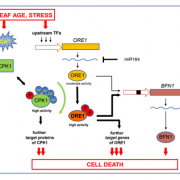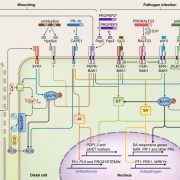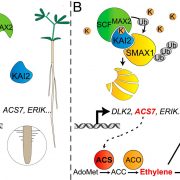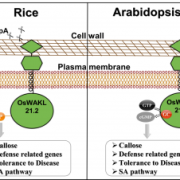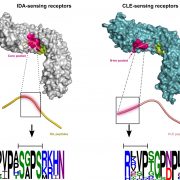Plant surveillance: The emerging role of substrate-binding proteins
 Plants are sessile organisms and, unlike animals, cannot escape adverse environmental conditions. To cope with this limitation, they have evolved a complex surveillance system to detect and respond to fluctuating conditions such as resource scarcity, environmental changes, and pathogen attacks. Membrane-bound receptors play a central role in these processes. It has long been recognized that plants possess a significantly larger repertoire of receptor-like kinases (RLKs) and receptor-like proteins (RLPs) compared to their mammalian counterparts—an adaptation thought to compensate for their lack of mobility. Traditionally, signal transduction in plants has been viewed through a relatively simple lens, primarily involving direct ligand–receptor interactions. In this new work, Pei and colleagues discuss new possibilities inspired by the mammalian system, and an emerging multi-functional RLK in plants – FERONIA. In many cases, substrate-binding proteins (SBPs) may act as intermediaries between ligands and receptors, offering structural and spatial flexibility as well as the ability to integrate multiple signals. This forum article presents new perspectives on unraveling the molecular mechanisms of signal transduction in plants, highlighting the critical roles of RLKs, RLPs, and their associated components. (Summary by Ching Chan @ntnuchanlab) Trends Plant Sci. 10.1016/j.tplants.2025.03.018
Plants are sessile organisms and, unlike animals, cannot escape adverse environmental conditions. To cope with this limitation, they have evolved a complex surveillance system to detect and respond to fluctuating conditions such as resource scarcity, environmental changes, and pathogen attacks. Membrane-bound receptors play a central role in these processes. It has long been recognized that plants possess a significantly larger repertoire of receptor-like kinases (RLKs) and receptor-like proteins (RLPs) compared to their mammalian counterparts—an adaptation thought to compensate for their lack of mobility. Traditionally, signal transduction in plants has been viewed through a relatively simple lens, primarily involving direct ligand–receptor interactions. In this new work, Pei and colleagues discuss new possibilities inspired by the mammalian system, and an emerging multi-functional RLK in plants – FERONIA. In many cases, substrate-binding proteins (SBPs) may act as intermediaries between ligands and receptors, offering structural and spatial flexibility as well as the ability to integrate multiple signals. This forum article presents new perspectives on unraveling the molecular mechanisms of signal transduction in plants, highlighting the critical roles of RLKs, RLPs, and their associated components. (Summary by Ching Chan @ntnuchanlab) Trends Plant Sci. 10.1016/j.tplants.2025.03.018


